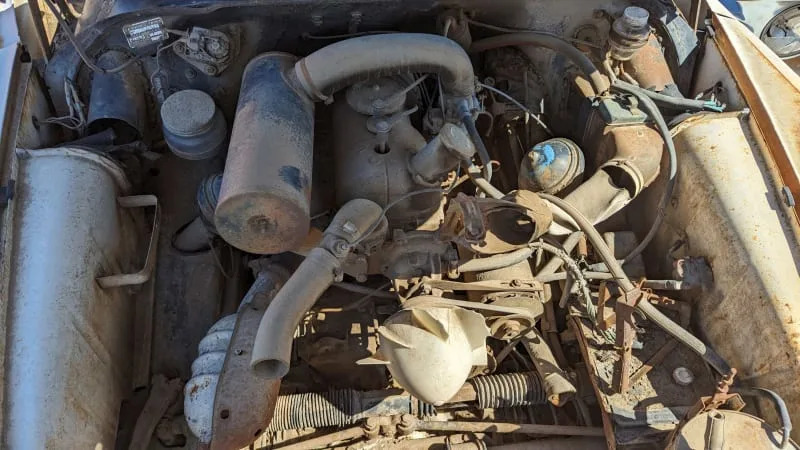Citroën introduced the motoring world to the Traction-Avant in 1934, and that front-drive unibody machine was so futuristic that it stayed in production all the way through 1957. Naturally, Citroën had to make the Traction-Avant’s successor even more radical, and the result was an engineering and styling masterpiece that seemed like something dropped down to the planet from a superior alien civilization: the DS, pronounced “Déese” (Goddess). In order to have a more direct replacement for the bargain-priced late Traction-Avant, a cheaper version of the DS known as the ID (pronounced “Idée,” meaning “Idea”) was introduced in 1957. Today’s Junkyard Gem is an early example of the ID, found in a self-service yard just south of Denver, Colorado.
This car is very rough, a basket case that appears to have spent about 50 years alternately roasting and freezing in the High Plains weather. The roof was pried off long ago and the interior is suitable mostly for families of raccoons.

It’s one of more than 100 vehicles from the 1930s through 1970s that are in the process of being placed in the regular U-Pull-It inventory, as a storage lot of vintage machinery gets emptied out. In addition to this Citroën, there are two Edsels, a Borgward Isabella, a pair of Austin Princesses and nearly two dozen 1964-1973 Ford Mustangs and Mercury Cougars.

This is only the fourth Citroën I’ve documented since I began writing about wrecking-yard inmates in 2007, after a 1961 ID19 wagon, a 1973 SM and a 1987 CX GTI.

The ID became the D Spécial for 1970, and Citroën sales in the United States ceased after 1973.

These cars were amazingly comfortable with their hydropneumatic suspensions and cushy seats, but most American car shoppers felt they were both too weird and too expensive for their taste. Then there was the matter of engine power; the 1959 ID19 had a 1.9-liter pushrod straight-four rated at 66 horsepower and 97 pound-feet.

The list price for this car was $2,833, or about $29,806 in 2023 dollars. Meanwhile, a new 1959 Mercury Monterey four-door sedan cost a dollar less than the ’59 Idée sedan (we can assume that those setting Mercury prices in Dearborn at that time were paying a lot more attention to GM prices than Citroën prices, so the single-buck difference is likely just coincidence), and the Merc came standard with a 312-cubic-inch (5.1-liter) V8 rated at 210 horsepower and fins that looked like something off a Redstone nuclear missile.

Speaking of nuclear missiles, this car’s Motorola AM radio has the CONELRAD nuke-attack-warning frequencies marked on the dial (the triangle-in-a-circle symbols at 640 and 1240 kHz).

Some of the more durable mechanical components on this car will be worth rescuing, but it’s too decayed for a restoration.
Just the thing for driving through a plowed field.
